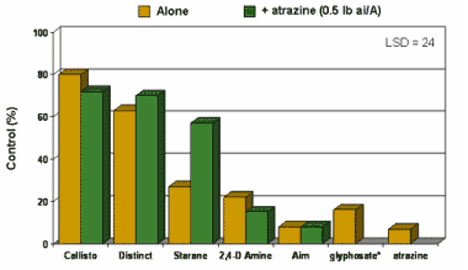Volunteer potato control in corn 2008
Editor’s note: This article is from the archives of the MSU Crop Advisory Team Alerts. Check the label of any pesticide referenced to ensure your use is included.
Corn growers in potato growing regions will be looking to control volunteer potatoes where potatoes were grown in 2007. It is important to control volunteer potatoes to preserve corn yield, however, it is as important to control volunteer potatoes to manage pests that can be a problem if potato is in rotation for next year. There are a few different options that will provide suppression of volunteer potato and significantly reduce the number of daughter tubers per plant; however, there currently are no herbicides available that will completely control volunteer potato. Michigan State University researchers (Renner, Lee, Long, and Powell) have evaluated the effectiveness of several different postemergence options for control of volunteer potatoes in corn. Herbicide treatments were applied when volunteer potatoes were between four and six inches tall. From this research, Callisto (3 fl oz) + crop oil concentrate (1.0 percent v/v) + ammonium sulfate (17 lb/100 gal); Callisto (3 fl oz) + atrazine (0.5 lb ai) + crop oil concentrate (1.0 percent v/v) + ammonium sulfate (8.5 lb/100 gal); Distinct (6 oz) + non-ionic surfactant (0.125 percent v/v) + ammonium sulfate (17 lb/100gal); and Distinct (6 oz) + atrazine (0.5 lb ai) + non-ionic surfactant (0.125 percent v/v) + ammonium sulfate (17 lb/100 gal) were the best options available for controlling volunteer potatoes, 28 days after treatment. These treatments also stopped daughter tuber production, reducing the risk of transmitting disease to the next year’s potato crop.
Good suppression of volunteer potatoes in the MSU trial was also obtained with Starane (1.33 pt) + atrazine (0.5 lb ai). However, in this trial Starane was applied at 1.33 pt/A, and is currently labeled at 0.67 pt/A for suppression of volunteer potatoes in corn with a maximum application rate of 1.33 pt/A per growing season. Starane has a similar mode of action as Distinct, Clarity, Stinger and 2,4-D and has been used in small grains for a number of years and has been registered for use in field corn. It is important to remember to be cautious when using this herbicide around sensitive broadleaf crops, such as, soybeans, sugar beets, grapes and dry beans. Starane is labeled for preplant and postemergence applications up to V5 (5 fully exposed leaf collars) corn at 0.67 pt/A for suppression of volunteer potatoes.
Something to consider
Corn inbreds are sensitive to many herbicides labeled in field corn. Consult the seed company agronomist before using any herbicides for weed control on inbreds. The only treatments that can be applied to seed corn that provided good suppression of volunteer potatoes were Callisto and Callisto + atrazine. Corn inbreds vary in their sensitivity to herbicides including Callisto, so it is important to consult the seed company on their inbred tolerances to Callisto.
 |
Figure 1. Volunteer potato control with postemergence herbicide treatments in corn. Graph credit: Dr. C. Sprague |



 Print
Print Email
Email


